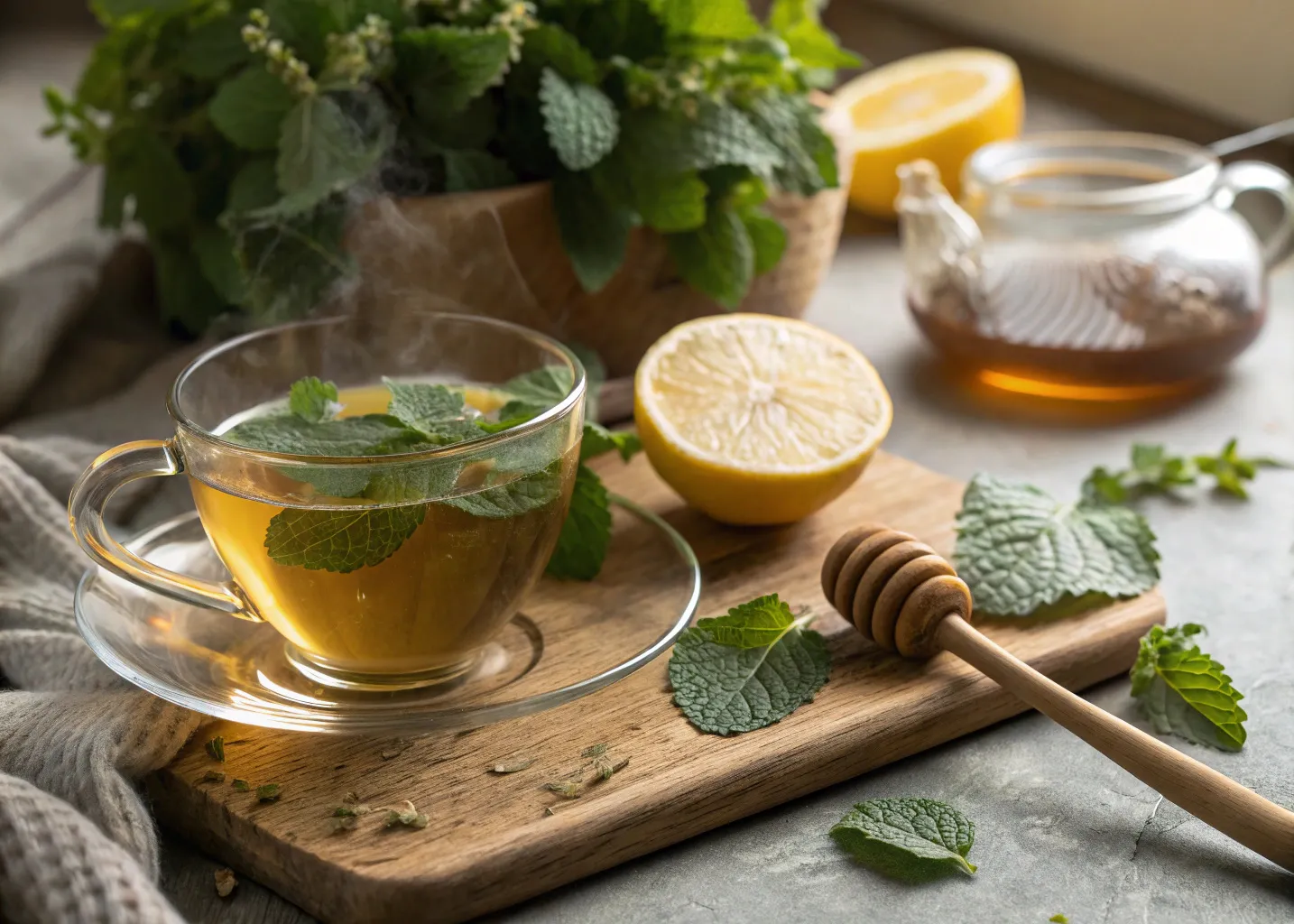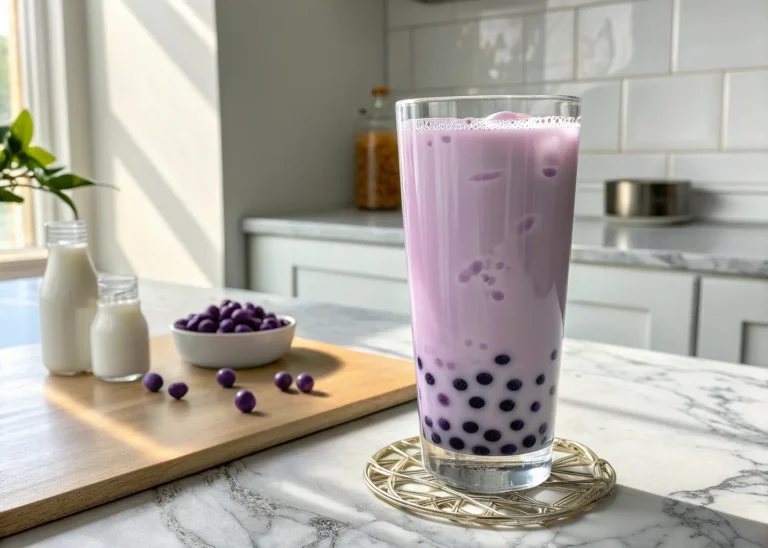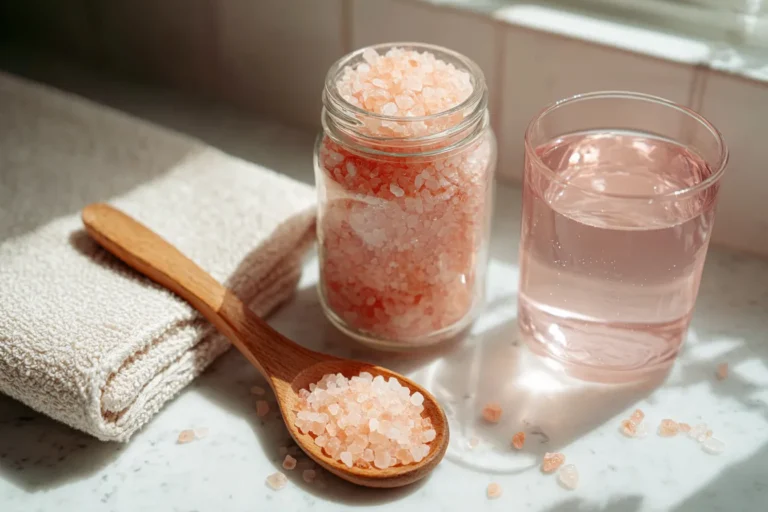Lemon balm isn’t just another pretty herb in the garden—it’s a powerhouse of flavor, calm, and healing. Whether you’re sipping it in a warm cup of tea, blending it into a smoothie, or using it to ease stress naturally, lemon balm recipes can easily become a staple in your daily routine.
This guide walks you through everything you need to know: how to use fresh lemon balm, the best lemon balm recipe for weight loss, creative ways to enjoy it raw, and even its magical herbal benefits. Whether you’re a home cook, a tea lover, or someone looking for natural wellness remedies, you’ll find tasty and easy ways to work this versatile herb into your lifestyle.
Looking for inspiration? Try this trending herbal drink recipe to explore another great weight-loss-friendly option with natural ingredients.
What Is Lemon Balm and Why You Should Use It
What is Lemon Balm? Botanical Origins and History
Lemon balm (Melissa officinalis) is a fragrant, lemon-scented perennial herb from the mint family, well-known for its calming effects and wide range of health benefits. Native to the Mediterranean and parts of Europe, this versatile herb has been used in culinary and medicinal recipes for over 2,000 years. Ancient civilizations, including the Greeks and Romans, relied on lemon balm to ease digestive discomfort, reduce anxiety, and promote emotional balance. Herbalists throughout history have praised it as a natural remedy to relieve stress, improve mood, and support deep, restful sleep.
Today, lemon balm continues to be a popular herb in natural wellness routines, valued for its light citrus scent, soothing flavor, and gentle healing properties. It’s a staple in herbal remedies, teas, and holistic recipes designed to promote calm, clarity, and overall well-being.
Health Benefits of Lemon Balm Backed by Science
Lemon balm isn’t just about taste—it’s a natural stress-buster. Modern studies suggest it may help:
- Reduce anxiety and improve mood
- Support better sleep quality
- Ease digestive discomfort
- Improve focus and alertness
- Fight cold sores due to its antiviral compounds
Lemon balm is packed with antioxidants, essential oils, and powerful plant compounds like rosmarinic acid, which contribute to its reputation in herbal medicine. Whether enjoyed as a calming tea, taken as a concentrated extract, or used in everyday recipes, lemon balm is widely recognized for its ability to support emotional balance, ease tension, and promote natural relaxation.
Culinary and Medicinal Uses: Why It’s a Kitchen Staple
You can use lemon balm in teas, salads, sauces, marinades, desserts, tinctures, and even skincare balms. It’s gentle enough for daily use and pairs beautifully with fruits, honey, green tea, and even chicken or fish (but we’ll skip pork-based pairings in this guide).
Its subtle lemon flavor doesn’t overpower other ingredients, which makes it ideal for layering flavor into both sweet and savory dishes. Medicinally, it’s often brewed as a tea or used in essential oil blends for stress relief and focus.
What Can I Do With Fresh Lemon Balm?
Fresh Lemon Balm vs. Dried: What’s Better for Cooking?
When it comes to using lemon balm in recipes, freshness matters. Fresh lemon balm leaves offer a more vibrant flavor, delicate citrus aroma, and a soft texture that blends seamlessly into teas, dressings, and infusions. Dried lemon balm, while convenient and shelf-stable, loses much of that natural brightness and can taste muted.
Here’s a quick comparison table:
| Feature | Fresh Lemon Balm | Dried Lemon Balm |
|---|---|---|
| Flavor | Bright, citrusy, herbal | Subtle, slightly earthy |
| Best For | Teas, salads, syrups, garnishes | Infusions, baking, long-simmered dishes |
| Shelf Life | 7–10 days (refrigerated) | 6–12 months (airtight container) |
| Aroma | Strong, fresh, lemon-like | Mild, more herbal |
If you have access to the fresh stuff—use it. It shines in recipes like infused waters, cooling summer teas, vinaigrettes, and even fruity desserts.
Top Ways to Use Fresh Lemon Balm in Meals and Drinks
Wondering how to actually put fresh lemon balm to use? Here are creative and practical ideas:
1. Lemon Balm Herbal Tea
Steep 1–2 tablespoons of torn lemon balm leaves in hot water for 10 minutes. Add honey or ginger for extra flavor. It’s great for calming nerves or winding down before bed.
2. Infused Water or Lemonade
Add a handful of lemon balm leaves to a pitcher of cold water, cucumber slices, and lemon wheels. Let it sit in the fridge for 2 hours. You’ll get a hydrating, belly-soothing detox drink.
3. Fresh Herb Salads
Chop lemon balm and mix it with parsley, mint, and baby greens. Top with olive oil, lemon juice, and sunflower seeds for a light, nutrient-dense salad.
4. Lemon Balm-Infused Syrup
Simmer equal parts sugar and water with a handful of lemon balm leaves for 10 minutes. Strain and refrigerate. Use it in iced teas, mocktails, or even drizzled on fruit.
5. Smoothies & Juices
Blend fresh lemon balm into green smoothies or fresh-pressed juices for a calming herbal note that pairs beautifully with apple, cucumber, and celery.
6. Chutneys & Sauces
Lemon balm is a great alternative to basil or mint in chutneys, especially when paired with mango or citrus for a bright, refreshing flavor.
Discover great ideas like this cottage cheese-based dessert if you’re looking for creamy ways to balance herbal flavors with sweet treats.
The Best Lemon Balm Recipe for Beginners
Simple Lemon Balm Tea for Relaxation and Wellness
For lemon balm beginners, a warm herbal tea is the simplest and most soothing way to start—caffeine-free, easy to digest, and naturally calming.
Here’s the go-to beginner-friendly lemon balm tea recipe:
Ingredients:
- 1 cup fresh lemon balm leaves (loosely packed) or 1 tbsp dried
- 2 cups water
- Optional: honey, lemon slices, or fresh ginger
Instructions:
- Wash the lemon balm leaves and lightly crush them to release the oils.
- Bring water to a boil, then remove from heat.
- Add lemon balm to the water, cover, and steep for 10–12 minutes.
- Strain, sweeten with honey if desired, and enjoy warm or iced.
Why it works:
Lemon balm tea may ease anxiety, reduce restlessness, and improve sleep—perfect for a calming evening routine. It’s one of the most versatile lemon balm recipes and a great entry point for exploring herbal wellness.
Lemon Balm-Infused Honey: A Soothing Natural Remedy
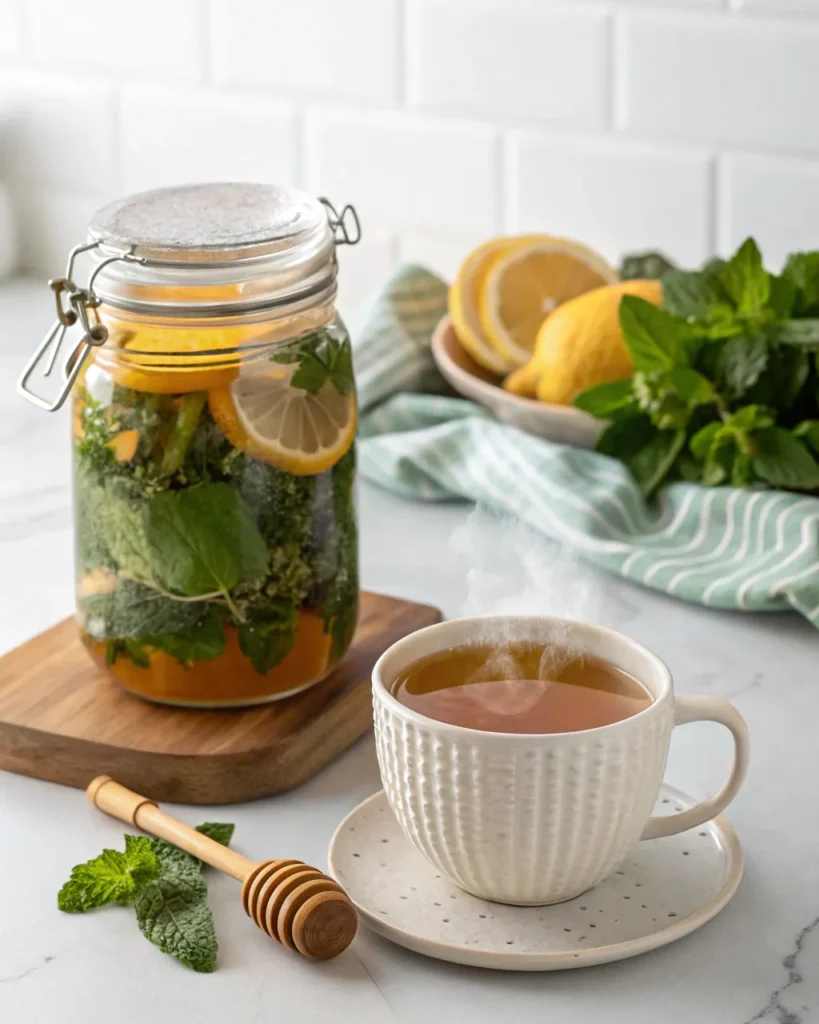
This is a gentle, functional recipe that combines the healing benefits of lemon balm with raw honey. Ideal for sore throats, stress relief, or adding to teas and toast.
Ingredients:
- 1 cup fresh lemon balm (chopped)
- 1 cup raw organic honey (mild flavor)
Instructions:
- Fill a clean glass jar halfway with lemon balm.
- Pour honey over the herb, using a chopstick or spoon to remove air bubbles.
- Seal and store in a dark cabinet for 2–3 weeks, flipping the jar occasionally.
- Strain if desired, or leave the herbs in for a rustic feel.
Usage tips:
- Add a spoonful to tea or warm water
- Drizzle on yogurt, oatmeal, or toast
- Use as a homemade cough soother
This recipe is especially helpful during cold months, but it’s a year-round favorite for natural wellness lovers.
Lemon Balm Recipe for Weight Loss
How Lemon Balm Supports Weight Loss Naturally
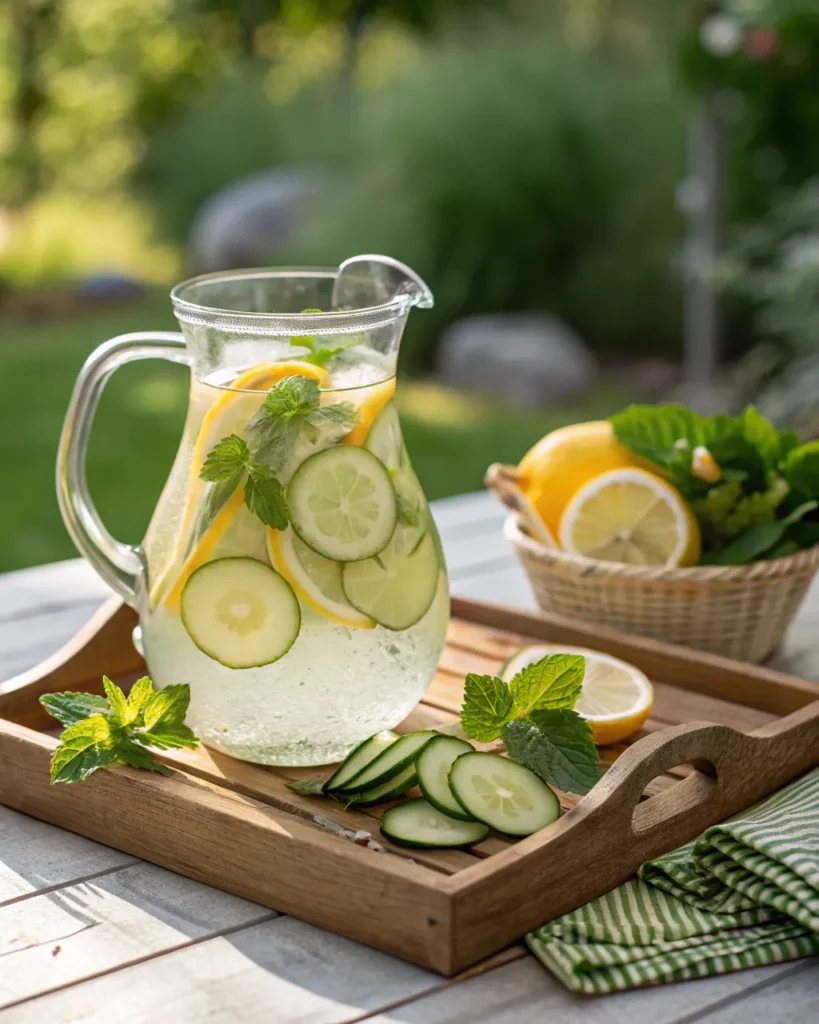
Lemon balm isn’t a magic pill—but it can support healthy weight loss as part of a balanced lifestyle. It works best by targeting the underlying causes of stubborn weight gain, such as:
- High cortisol (stress hormone): Lemon balm has calming properties that reduce anxiety and stress, which can trigger belly fat storage.
- Poor sleep: Research shows that better sleep is linked to improved metabolism. Lemon balm can help you wind down and improve sleep quality.
- Digestive sluggishness: Its mild carminative (gas-relieving) effects may aid digestion, reduce bloating, and improve gut comfort.
While lemon balm alone won’t melt pounds, it fits perfectly in a supportive weight loss plan focused on hydration, stress management, and hormonal balance.
Step-by-Step Recipe: Lemon Balm Detox Water & Tea
This lemon balm detox recipe is hydrating, naturally diuretic, and gentle on your system—perfect for bloating and water weight. Use it daily or as part of a clean eating reset.
Lemon Balm Detox Water (Cold Infusion)
Ingredients:
- 1 handful fresh lemon balm (or 1 tbsp dried)
- ½ cucumber, sliced
- ½ lemon, thinly sliced
- 1 liter filtered water
- Optional: mint, basil, or apple slices
Instructions:
- Add all ingredients to a large glass pitcher.
- Let it sit in the fridge for 4–6 hours (overnight is better).
- Drink throughout the day.
Benefits:
- Boosts hydration
- May reduce water retention
- Supports digestion
Lemon Balm Fat-Burning Tea
Ingredients:
- 1 tbsp fresh lemon balm (or 1 tsp dried)
- 1 tsp green tea or oolong tea (optional for caffeine)
- 1 slice fresh ginger
- Juice from ¼ lemon
- 1–2 cups boiling water
Instructions:
- Steep all ingredients for 5–10 minutes.
- Strain and drink warm.
- Drink in the morning or before meals to support digestion.
This tea blends lemon balm’s calming properties with green tea’s metabolism boost, creating a gentle, effective fat-burning drink.
Magical Uses of Lemon Balm in Herbalism
Lemon Balm in Traditional Healing and Spiritual Practices
For centuries, lemon balm has been more than just a kitchen herb—it’s been a sacred plant in folk medicine, rituals, and herbal magic. Rooted in ancient Greek, Roman, and medieval European traditions, lemon balm (Melissa officinalis) has long been associated with:
- Peace and emotional balance
- Healing energy and heart-centered intentions
- Protection from negativity
- Love and friendship rituals
In herbal folklore, lemon balm is often called the “herb of the moon,” believed to enhance calm, intuition, and inner reflection. It was commonly planted near doorways to invite peace into the home.
Today, herbalists and energy practitioners still use it in:
- Herbal baths for emotional cleansing
- Sleep sachets or dream pillows for restful nights
- Anointing oils or infusions to support mental clarity and heart chakra work
Its gentle lemon scent is thought to uplift and purify both spaces and moods—making it a lovely addition to modern wellness rituals.
How to Prepare Lemon Balm Tinctures, Oils, and Salves
Whether you’re crafting your own apothecary cabinet or just looking to explore herbal DIY, lemon balm is a beginner-friendly herb for natural remedies. Here’s how to start.
Lemon Balm Tincture (Alcohol-Based Herbal Extract)
Ingredients:
- 1 cup fresh lemon balm (chopped)
- 2 cups 80–100 proof vodka or grain alcohol
- Clean glass jar with lid
Instructions:
- Add lemon balm to the jar and cover with alcohol.
- Seal and store in a dark, cool place for 4–6 weeks.
- Shake the jar every few days.
- Strain and bottle in a dark dropper bottle.
Suggested use: Add 10–20 drops to water or tea for a calming effect. Consult a qualified herbalist or healthcare provider before internal use.
Lemon Balm Oil Infusion (Topical Use)
Ingredients:
- 1 cup dried lemon balm (to prevent mold)
- 1 cup carrier oil (olive, almond, or jojoba)
- Glass jar with lid
Instructions:
- Place dried lemon balm and carrier oil into a clean glass jar.
- Let infuse for 2–3 weeks in a sunny window or use the low-heat method (double boiler).
- Strain and store in a dark glass bottle.
Use: Apply to temples, neck, or wrists for relaxation. Can also be used in DIY balms or massage oils.
Can You Eat Lemon Balm Raw or Fresh?
Safety and Nutritional Profile of Raw Lemon Balm
Yes—you can absolutely eat lemon balm raw. It’s not only safe but also full of plant-based nutrients that are best preserved when the herb is consumed fresh and uncooked. When eaten raw, lemon balm offers:
- Natural antioxidants (including rosmarinic acid)
- Mild antimicrobial compounds
- Essential oils that calm and support digestion
- Trace vitamins like vitamin C and small amounts of magnesium and iron
Fresh lemon balm is non-toxic, gentle, and suitable for most people—including kids and older adults. However, if you’re pregnant, breastfeeding, or taking thyroid medication, it’s best to consult a healthcare provider before using it regularly.
Its light, citrusy flavor makes it ideal for dishes where herbs are used raw, like garnishes or mixed into cold foods.
Raw Lemon Balm in Salads, Smoothies & More
Need easy ways to eat lemon balm raw? Here are some quick and healthy ideas that don’t require any cooking:
1. Lemon Balm Green Smoothie
Ingredients:
- 1 banana
- 1 handful spinach
- ½ apple (or pear)
- 5–6 fresh lemon balm leaves
- 1 cup almond milk or water
- Optional: flaxseeds, chia, or a scoop of protein
Blend until smooth. The lemon balm gives it a refreshing twist, perfect for a post-workout drink or an afternoon recharge.
2. Fresh Herb Salad Mix
Tear lemon balm leaves and combine with:
- Baby arugula
- Chopped cucumber
- Sliced strawberries
- Crumbled feta or goat cheese (optional)
- Light lemon vinaigrette
This combination is light, refreshing, and loaded with antioxidants.
3. Lemon Balm Fruit Bowl
Toss chopped lemon balm into a bowl of:
- Sliced peaches
- Blueberries
- Watermelon
- A drizzle of honey or fresh lime juice
It adds just enough brightness without overpowering the fruit.
4. Herbal Avocado Toast
Spread mashed avocado on toast and top with chopped lemon balm, red pepper flakes, and a squeeze of lemon. It’s a quick savory snack with a fresh herbal punch.
The Best Way to Consume Lemon Balm Daily
Lemon Balm Capsules, Teas, Extracts: Which Is Best?
If you’re wondering how to include lemon balm into your everyday wellness plan, the good news is—there’s no one-size-fits-all answer. It all comes down to your health goals, lifestyle, and taste preference.
Here’s a quick breakdown of the most common forms of daily lemon balm use:
| Form | Best For | How to Use It |
|---|---|---|
| Fresh leaves | Culinary use, teas, smoothies | Add to drinks, salads, and fresh dishes |
| Dried leaves | Long-term storage, herbal teas | Brew 1–2 tsp per cup of boiling water |
| Liquid extract | Quick dosing, concentrated effects | Use drops under tongue or in water |
| Capsules | Convenience, standardized doses | Follow label—usually 300–500 mg daily |
| Infused oils/balms | Topical stress relief or skincare | Rub on skin or add to DIY body products |
Among all these, lemon balm tea remains the most affordable, effective, and time-tested way to support daily calm and digestion—plus, it’s easy to personalize with ginger, honey, or citrus.
How to Include Lemon Balm in Your Daily Diet Safely
If you’re new to lemon balm, start with small amounts and observe how your body responds. Here are some easy ways to build a lemon balm habit into your day:
Morning:
- Add lemon balm to your smoothie or green juice
- Make a warm tea with lemon balm + lemon + honey
- Drop a few leaves into your water bottle for subtle flavor
Afternoon:
- Eat a light salad with lemon balm as a fresh herb
- Add to homemade hummus or dip for herbal flavor
- Take a liquid extract if you’re feeling stressed or foggy
Evening:
- Brew a calming tea before bed
- Massage lemon balm-infused oil on neck or shoulders
- Use it in a relaxing bath soak (paired with lavender or chamomile)
📝 Tip: For general wellness, up to 2–3 cups of lemon balm tea daily is considered safe for most adults. Always rotate your herbs and avoid long-term use without breaks, especially if you’re on thyroid meds.
Creative Culinary Lemon Balm Recipes

Savory Lemon Balm Dishes: Sauces, Soups, and Marinades
While lemon balm is most famous for teas and desserts, it adds a subtle citrus-herbal flavor that’s perfect for savory recipes too. Think of it as a gentler, more soothing cousin to mint or lemon thyme.
Here are some creative ways to use lemon balm in savory dishes:
1. Lemon Balm Pesto
A fresh twist on the Italian classic—this pesto is lighter and more aromatic.
Ingredients:
- 1 cup fresh lemon balm leaves
- ½ cup parsley or basil (optional)
- ⅓ cup olive oil
- ¼ cup sunflower seeds (or pine nuts)
- 1 garlic clove
- Salt to taste
- Juice of ½ lemon
Instructions:
Blend all ingredients in a food processor until smooth. Use as a dip, sandwich spread, or pasta sauce.
2. Lemon Balm Marinade for Chicken or Fish
Perfect for grilled or baked dishes.
Mix together:
- 2 tbsp chopped lemon balm
- 1 tbsp olive oil
- 1 tsp lemon zest
- 1 tsp Dijon mustard
- Salt, pepper
- Optional: minced garlic or shallots
Let protein marinate for 30–60 minutes before cooking. This gives a fresh, zesty finish without overpowering.
3. Cold Summer Soup (Herbal Gazpacho)
Toss chopped lemon balm into cold tomato or cucumber gazpacho just before serving. It balances acidity and brings a cool herbal lift.
Sweet Recipes: Lemon Balm Ice Cream, Cookies & Syrups
Lemon balm also shines in sweet applications. Its lemony profile plays well with fruit, honey, vanilla, and creamy textures.
1. Lemon Balm Herbal Ice Cream
Base ingredients:
- 2 cups heavy cream
- 1 cup whole milk
- ¾ cup sugar
- ½ cup fresh lemon balm, finely chopped
- 1 tsp vanilla extract
Instructions:
- Gently heat milk, sugar, and lemon balm in a saucepan without boiling.
- Let steep 30 minutes, then strain and cool.
- Mix with cream and vanilla.
- Transfer to an ice cream maker and churn according to manufacturer instructions.
Light, citrusy, and refreshing.
2. Lemon Balm Shortbread Cookies
Dry mix:
- 1½ cups all-purpose flour
- ½ cup powdered sugar
- ½ cup unsalted butter (cold, cubed)
- 1 tbsp finely minced lemon balm
Instructions:
Combine in a food processor until a dough forms. Chill 30 minutes, roll, cut, and bake at 350°F for 12–15 minutes. Herbal, buttery, and perfect with tea.
3. Lemon Balm Simple Syrup
Use this syrup in cocktails, lemonade, or to drizzle on pancakes and desserts.
Simmer:
- 1 cup water
- 1 cup sugar
- 1 handful fresh lemon balm
Simmer for 10 minutes, strain, cool, and bottle. Keeps in the fridge for 2 weeks.
Looking for something rich and satisfying? Try our cottage cheese cookie dough recipe as a protein-packed dessert to pair with your herbal drinks.
Growing, Storing, and Preserving Lemon Balm
How to Grow Lemon Balm at Home (Indoors or Outdoors)
One of the best things about lemon balm? It’s easy to grow—even if you don’t have a green thumb. Whether you’re working with a windowsill or a backyard herb patch, lemon balm thrives in a variety of environments.
Basic Growing Requirements:
- Sunlight: Full sun to partial shade (at least 4–6 hours of light daily)
- Soil: Well-draining, moderately rich soil with a pH of 6.0–7.5
- Watering: Keep soil slightly moist but not soggy
- Container-friendly? Yes! Grows well in pots or raised beds
Tip: As a mint family herb, lemon balm spreads quickly—grow it in containers or prune often to manage growth.
How to Start:
- From seeds: Sow indoors 6–8 weeks before last frost, then transplant outdoors.
- From cuttings: Root fresh stems in water and plant when roots form.
- From nursery plants: The fastest option—just transplant and go!
You can start harvesting once the plant reaches about 6–8 inches tall. Snip leaves in the morning for the best flavor.
Harvesting Tips and Best Storage Methods for Freshness
To enjoy the benefits of lemon balm recipes year-round, proper harvesting and storage are key. Here’s how to get the most out of your herb:
How to Harvest Lemon Balm:
- Use clean scissors or pruning shears.
- Cut leaves just above a node (where two leaves grow from the stem).
- Harvest in the morning after the dew dries but before the sun is harsh.
- Avoid harvesting more than one-third of the plant at once to maintain healthy growth.
Best Storage Methods:
| Method | Shelf Life | How to Use After |
|---|---|---|
| Refrigeration | 5–7 days | Wrap in a damp paper towel in a zip bag |
| Freezing | 3–6 months | Freeze in ice cube trays with water or oil |
| Drying | 6–12 months | Air dry or use a dehydrator; store airtight |
| Infusions/Syrups | 2–4 weeks (fridge) | Use in teas, marinades, and desserts |
🪴 Bonus Tip: Plant lemon balm near tomatoes or squash to naturally repel pests and enhance your garden’s appearance.
✅ Frequently Asked Questions About Lemon Balm
What are the easiest lemon balm recipes to start with?
The best beginner-friendly lemon balm recipes include simple herbal teas, infused waters, and syrups. These require minimal prep and help you get familiar with its gentle lemony flavor. A quick lemon balm tea or a chilled detox water with lemon slices and cucumber is the perfect place to begin.
How does lemon balm tea support stress relief and sleep?
Lemon balm tea contains calming compounds like rosmarinic acid, which can help reduce anxiety, improve sleep quality, and promote relaxation. Drinking 1–2 cups before bedtime may help calm your nervous system and support more restful sleep.
Can lemon balm be used in smoothies or desserts?
Yes! Fresh lemon balm blends beautifully into smoothies, fruit bowls, and herbal desserts. It pairs well with berries, citrus, honey, and creamy ingredients like yogurt or cottage cheese. You can even infuse it into ice cream or bake it into cookies.
Is lemon balm good for weight loss and metabolism?
Lemon balm may support weight loss indirectly by helping reduce stress-induced cravings, improving digestion, and promoting better sleep—all key factors in healthy metabolism. While not a fat burner itself, it’s a useful herb in a balanced wellness plan.
How do you make a natural remedy with lemon balm?
You can make a simple lemon balm tincture or infused oil to use as a calming remedy. Tinctures support emotional balance when taken in drops, while oils are great for topical use. Lemon balm honey is another popular folk remedy for cold season support.
What does lemon balm taste like and how can I cook with it?
Lemon balm tastes lightly citrusy with subtle mint and herb notes. It’s excellent in teas, salad dressings, marinades, and fruit-based desserts. Its mild flavor means you can use it generously without overpowering other ingredients.
🟩 Conclusion: Add Fresh Lemon Balm to Your Kitchen and Wellness Routine
Whether you’re making a soothing herbal tea, infusing fresh lemon balm into your favorite dishes, or exploring its role in natural remedies, lemon balm recipes offer a world of health and flavor.
This humble herb can support your body, calm your mind, and uplift your meals—all from one leafy plant. From stress relief to digestion support and creative culinary uses, it’s time to make lemon balm a regular part of your day.
This humble herb can support your body, calm your mind, and uplift your meals—all from one leafy plant. From stress relief to digestion support and creative culinary uses, it’s time to make lemon balm a regular part of your day.
Looking to expand your herb-based cooking even further?
Don’t miss our bold and flavorful Rasta Pasta Recipe—a perfect example of how herbs can elevate savory meals with heat, richness, and depth.
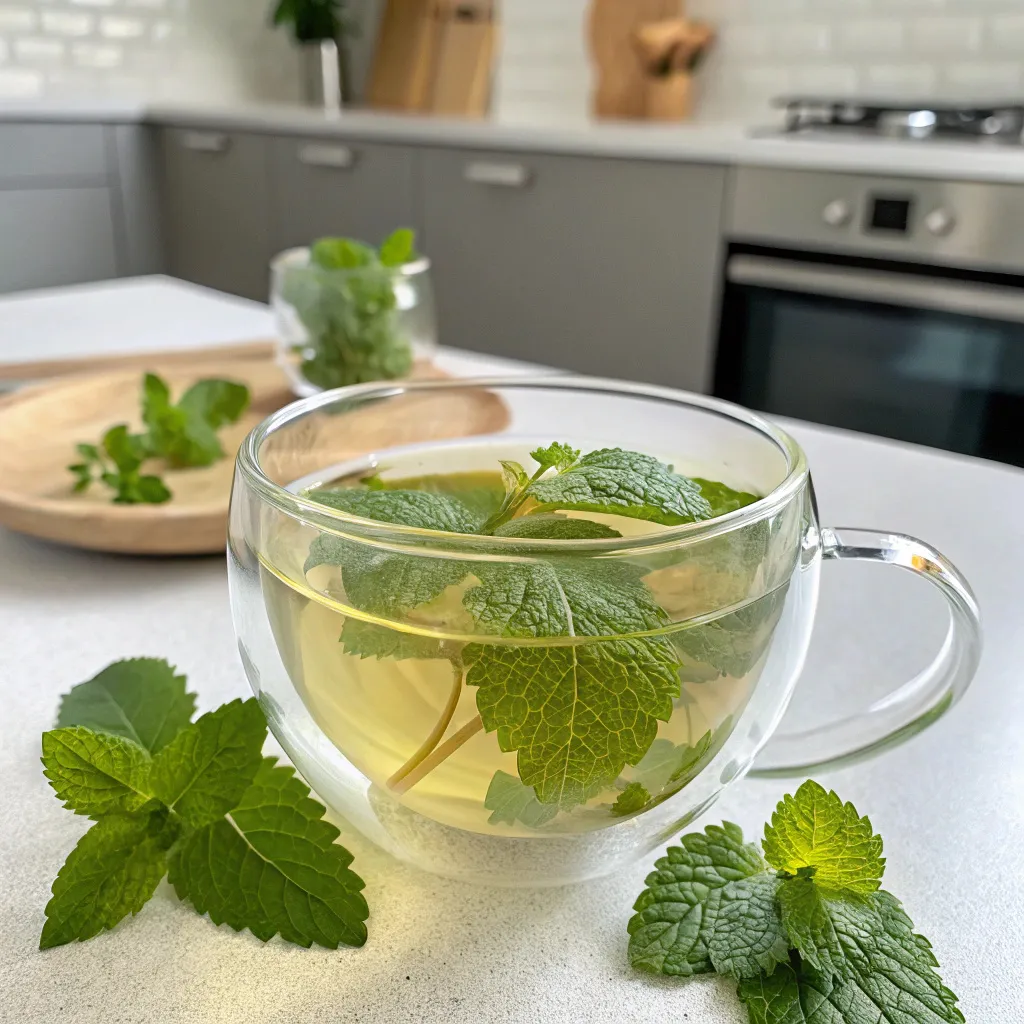
Calming Lemon Balm Tea
Ingredients
Equipment
Method
- Wash and lightly crush the lemon balm leaves to release the oils.
- Bring water to a boil, then remove from heat.
- Add lemon balm to the water, cover, and steep for 10–12 minutes.
- Strain the tea into a mug.
- Add honey, lemon, or ginger if desired.
- Enjoy warm or iced for a calming, herbal refreshment.
Notes
- This caffeine-free tea is ideal before bed or during stressful days. Lemon balm supports relaxation, sleep, and digestion. You can also combine it with chamomile or lavender for a deeper calming effect.


